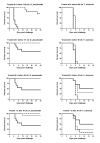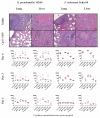CpG oligodeoxyribonucleotides protect mice from Burkholderia pseudomallei but not Francisella tularensis Schu S4 aerosols
- PMID: 20181102
- PMCID: PMC2830940
- DOI: 10.1186/1476-8518-8-2
CpG oligodeoxyribonucleotides protect mice from Burkholderia pseudomallei but not Francisella tularensis Schu S4 aerosols
Abstract
Studies have shown that CpG oligodeoxyribonucleotides (ODN) protect mice from various bacterial pathogens, including Burkholderia pseudomallei and Francisella tularensis live vaccine strain (LVS), when administered before parenteral challenge. Given the potential to develop CpG ODN as a pre-treatment for multiple bacterial biological warfare agents, we examined survival, histopathology, and cytokine data from CpG ODN-treated C57BL/6 mice to determine whether previously-reported protection extended to aerosolized B. pseudomallei 1026b and highly virulent F. tularensis Schu S4 infections. We found that, although CpG ODN protected mice from aerosolized B. pseudomallei challenges, the immunostimulant failed to benefit the animals exposed to F. tularensis Schu S4 aerosols. Our results, which contrast with earlier F. tularensis LVS studies, highlight potential differences in Francisella species pathogenesis and underscore the need to evaluate immunotherapies against human pathogenic species.
Figures


Similar articles
-
A Francisella tularensis Schu S4 purine auxotroph is highly attenuated in mice but offers limited protection against homologous intranasal challenge.PLoS One. 2008 Jun 25;3(6):e2487. doi: 10.1371/journal.pone.0002487. PLoS One. 2008. PMID: 18575611 Free PMC article.
-
Characterization of Francisella tularensis Schu S4 defined mutants as live-attenuated vaccine candidates.Pathog Dis. 2015 Aug;73(6):ftv036. doi: 10.1093/femspd/ftv036. Epub 2015 May 17. Pathog Dis. 2015. PMID: 25986219 Free PMC article.
-
Francisella tularensis Live Vaccine Strain deficient in capB and overexpressing the fusion protein of IglA, IglB, and IglC from the bfr promoter induces improved protection against F. tularensis respiratory challenge.Vaccine. 2016 Sep 22;34(41):4969-4978. doi: 10.1016/j.vaccine.2016.08.041. Epub 2016 Aug 28. Vaccine. 2016. PMID: 27577555 Free PMC article.
-
Characterization of Schu S4 aro mutants as live attenuated tularemia vaccine candidates.Virulence. 2020 Dec;11(1):283-294. doi: 10.1080/21505594.2020.1746557. Virulence. 2020. PMID: 32241221 Free PMC article.
-
Animal models of Francisella tularensis infection.Ann N Y Acad Sci. 2007 Jun;1105:238-65. doi: 10.1196/annals.1409.003. Epub 2007 Mar 29. Ann N Y Acad Sci. 2007. PMID: 17395735 Review.
Cited by
-
Intranasal prophylaxis with CpG oligodeoxynucleotide can protect against Yersinia pestis infection.Infect Immun. 2013 Jun;81(6):2123-32. doi: 10.1128/IAI.00316-13. Epub 2013 Apr 1. Infect Immun. 2013. PMID: 23545300 Free PMC article.
-
Cationic liposomes extend the immunostimulatory effect of CpG oligodeoxynucleotide against Burkholderia pseudomallei infection in BALB/c mice.Clin Vaccine Immunol. 2012 May;19(5):675-83. doi: 10.1128/CVI.05545-11. Epub 2012 Mar 21. Clin Vaccine Immunol. 2012. PMID: 22441390 Free PMC article.
-
Low-dose exposure of C57BL/6 mice to burkholderia pseudomallei mimics chronic human melioidosis.Am J Pathol. 2011 Jul;179(1):270-80. doi: 10.1016/j.ajpath.2011.03.031. Epub 2011 May 5. Am J Pathol. 2011. PMID: 21703409 Free PMC article.
-
Single-stranded DNA oligonucleotides containing CpG motifs are non-stimulatory in vitro but offer protection in vivo against Burkholderia pseudomallei.Front Cell Infect Microbiol. 2024 Oct 18;14:1458435. doi: 10.3389/fcimb.2024.1458435. eCollection 2024. Front Cell Infect Microbiol. 2024. PMID: 39492991 Free PMC article.
-
Recovery efficiencies for Burkholderia thailandensis from various aerosol sampling media.Front Cell Infect Microbiol. 2012 Jun 11;2:78. doi: 10.3389/fcimb.2012.00078. eCollection 2012. Front Cell Infect Microbiol. 2012. PMID: 22919669 Free PMC article.
References
-
- Elkins KL, Rhinehart-Jones TR, Stibitz S, Conover JS, Klinman DM. Bacterial DNA containing CpG motifs stimulates lymphocyte-dependent protection of mice against lethal infection with intracellular bacteria. J Immunol. 1999;162(4):2291–2298. - PubMed
-
- Wongratanacheewin S, Kespichayawattana W, Intachote P, Pichyangkul S, Sermswan RW, Krieg AM, Sirisinha S. Immunostimulatory CpG oligodeoxynucleotide confers protection in a murine model of infection with Burkholderia pseudomallei. Infection and immunity. 2004;72(8):4494–4502. doi: 10.1128/IAI.72.8.4494-4502.2004. - DOI - PMC - PubMed
LinkOut - more resources
Full Text Sources
Other Literature Sources

